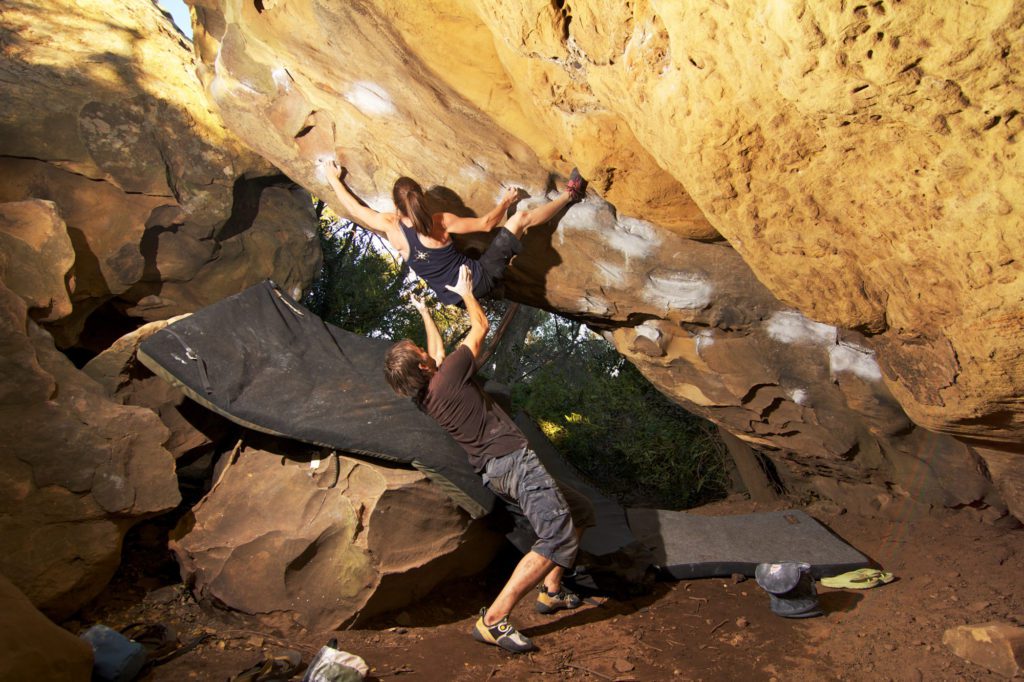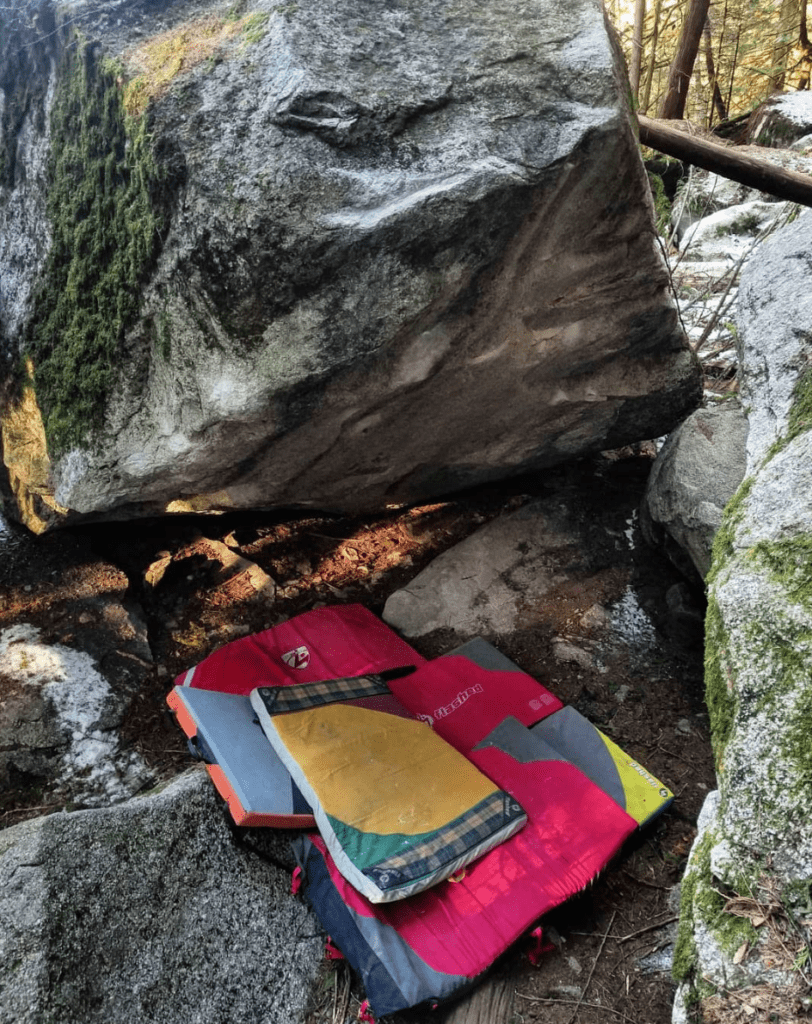Bouldering Outside? 5 Tips for a Safer Landing

Part of the beauty of bouldering outdoors is its simplicity. When it comes to safety equipment, you only need a crash pad or two. But you still need to know how to use them properly. At most indoor bouldering facilities these days, the flooring under the walls is a continuous, flat, thick, foam padding that covers a surface area so large it would be tough to miss if you tried. This is not the case outside.
Bouldering outdoors requires a smart crash pad set-up. Just throwing pads at the bottom of the climb does not always cut it. If you’re lucky, the ground is flat, but more often than not there are roots or rocks or the ground is sloping, so pad placement requires thought and effort, and should not be trivialized.
Below are 5 tips for how to create safer landings.
1. Look for “Fall Zones”
Be sure there are crash pads in the climber’s “fall zone,” i.e., where the climber will fall if she comes off the wall. This may sound obvious but the fall zone often goes beyond the base of the boulder, where the climber sits or stands to start. This is true particularly if the problem is steep, or if it traverses.
Envision where the climber is going to go – from beginning to end, including the top out if there is one – and make sure all of the falling zones are covered. It’s important to be generous when sussing out the fall zones because landing on the edge of a pad is a very common way climbers sprain their ankles.
If you don’t have enough pads, it is sometimes safe to move a pad from the beginning of a climb (once the climber is safely past that falling zone) and use it for more protection near the end.

2. Create a Level Landing
If the ground is uneven due to rocks or a slope, try to even out the landing by placing smaller pads in the “holes” (fold them if necessary to get the right height) and placing a larger pad on top. Test out your landing by walking on it to make sure a pad doesn’t collapse in a certain area.
A climber can fall safely on a slightly slanted padded area, but if the ground is too steep, she could go for a slide on the pad if it’s not secured in place or raised on the lower side to make it even.
3. Avoid Gaps Between Pads
Another way climbers get injured is from falling in gaps between pads. This can be avoided. Remember that pads sometimes move just from folks walking around the padded area, sitting on the pads, as well as from climbers falling on them. Do a quick surveillance and, if necessary, push or kick the pads together to eliminate any cracks in the landing before climbers pull off the ground.
Some crash pads are designed to attach together with velcro flaps, which keeps them from moving, which makes things nice and easy. It is also common these days to carry small, thinner “slider” pads that can be used to cover cracks. A small effort for a huge return in safety.

4. Stack Pads (Properly) For Higher Boulders
The higher the boulder, the harder the impact of the fall. So even if a landing is quite flat, you may want to make your landing two or three crash pads deep. That said, as you add pads, you can lose stability and gaps between pads get deeper so you need to take extra care with tips 1. to 3. when building up your landing.
Having lots of pads usually means there are lots of people, which is a good thing, because our last safety tip requires at least one other person.
5. Be a Good Spotter
Part of creating a safe landing for a climber, is being a good spotter. The job of the spotter is not to physically catch a falling climber, but rather to safely guide the falling climber onto the wonderful crash pad set up you have just created. As a climber, don’t hesitate to ask or remind fellow climbers to spot you.
Best spotting practice is to (a) have one foot behind the other to absorb even a surprise or uncontrolled fall without getting knocked over, (b) stand with hands out so you are prepared to (c) secure the climber at the hips to guide her to a feet-first landing. If there is a random rock or tree trunk near a fall zone, the spotter should direct the falling climber away from it. If a climber falls on her butt or back, especially with some momentum, look to protect the head from hitting anything off the pads.
There are occasions outside that do not require a close spot or even a spot at all. For example, a spotter will more likely be in the way of a climber on a steep and low-to-the-ground boulder. Or, if the climb goes straight up on a vertical wall and tops out relatively low, the climber is likely to fall straight down, in a predictable way, onto the predicted, well-protected area.

In sum, when bouldering outside, one’s mindset must be far and away different than it is for the indoor bouldering scenario. With the quality of indoor facilities today, climbers barely think about the landing anymore and spotters can actually get hurt or cause an injury by being on the mats while others are climbing. Outdoors, however, vigilance is key. So get outdoors this spring but do it safely!


